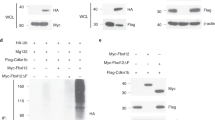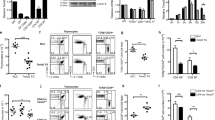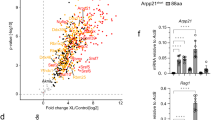Abstract
Activation of mitogen-activated protein kinase (MAPK) pathways leads to cellular differentiation and/or proliferation in a wide variety of cell types, including developing thymocytes. The basic helix-loop-helix (bHLH) proteins E12 and E47 and an inhibitor HLH protein, Id3, play key roles in thymocyte differentiation. We show here that E2A DNA binding is lowered in primary immature thymocytes consequent to T cell receptor (TCR)-mediated ligation. Whereas expression of E2A mRNA and protein are unaltered, Id3 transcripts are rapidly induced upon signaling from the TCR. Activation of Id3 transcription is regulated in a dose-dependent manner by the extracellular signal-regulated kinase (ERK) MAPK module. These observations directly connect the ERK MAPK cascade and HLH proteins in a linear pathway.
This is a preview of subscription content, access via your institution
Access options
Subscribe to this journal
Receive 12 print issues and online access
$209.00 per year
only $17.42 per issue
Buy this article
- Purchase on Springer Link
- Instant access to full article PDF
Prices may be subject to local taxes which are calculated during checkout







Similar content being viewed by others
References
Murre, C. et al. Structure and function of helix-loop-helix proteins. Biochim. Biophys. Acta 1218, 129–135 (1994).
Naya, F. J. et al. Diabetes, defective pancreatic morphogenesis, abnormal enteroendocrine differentiation in BETA2/NeuroD-deficient mice. Genes Dev. 11, 2323–2334 (1997).
Lee, J. E. et al. Conversion of Xenopus ectoderm into neurons by NeuroD, a basic helix-loop-helix protein. Science 268, 836–844 (1995).
Lassar, A. B. et al. Functional activity of myogenic HLH proteins requires hetero-oligomerization with E12/E47-like proteins in vivo. Cell 66, 305–315 (1991).
Bain, G. et al. E2A proteins are required for proper B cell development and initiation of immunoglobulin gene rearrangements. Cell 79, 885–892. (1994).
Zhuang, Y., Soriano, P. & Weintraub, H. The helix-loop-helix gene E2A is required for B cell formation. Cell 79, 875–884. (1994).
Bain, G. et al. E2A deficiency leads to abnormalities in αβ T cell development and to the rapid development of T cell lymphomas. Mol. Cell. Biol. 17, 4782–4791 (1997).
Barndt, R., Dai, M. & Zhuang, Y. A novel role for HEB downstream or parallel to the pre-TCR signaling pathway during αβ thymopoiesis. J. Immunol. 163, 3331–3343 (1999).
Zhuang, Y., Cheng, P. & Weintraub, H. B-lymphocyte development is regulated by the combined dosage of three basic helix-loop-helix genes, E2A, E2-2, and HEB. Mol. Cell. Biol. 16, 2898–2905 (1996).
Bain, G., Quong, M. W., Soloff, R. S., Hedrick, S. M. & Murre, C. Thymocyte maturation is regulated by the activity of the helix-loop-helix protein, E47. J. Exp. Med. 190, 1605–1616 (1999).
Yan, W. et al. High incidence of T-cell tumors in E2A-null mice and E2A/Id1 double-knockout mice. Mol. Cell. Biol. 17, 7317–7327 (1997).
Engel, I. & Murre, C. Ectopic expression of E47 or E12 promotes the death of E2A-deficient lymphomas. Proc. Natl Acad. Sci. USA 96, 996–1001 (1999).
Park, S. T., Nolan, G. P. & Sun, X.-H. Growth inhibition and apoptosis due to restoration of E2A activity in T cell acute lymphoblastic leukemia cells. J. Exp. Med. 189, 501–508 (1998).
Engel, I. & Murre, C. Transcription factors in hematopoiesis. Curr. Opin. Gen. Dev. 9, 575–579 (1999).
Norton, J. D., Deed, R. W., Craggs, G. & Sablitzky, F. Id helix-loop-helix proteins in cell growth and differentiation. Trends Cell Biol. 8, 58–65 (1998).
Pan, L., Sato, S., Frederick, J. P., Sun, X.-H. & Zhaung, Y. Impaired immune responses and B-cell proliferation in mice lacking the Id3 gene. Mol. Cell. Biol. 19, 5969–5980 (1999).
Yokota, Y. et al. Development of peripheral lymphoid organs and natural killer cells depends on the helix-loop-helix inhibitor Id2. Nature 397, 702–706 (1999).
Lyden, D. et al. Id1 and Id3 are required for neurogenesis, angiogenesis and vascularization of tumor xenografts. Nature 401, 670–677 (1999).
Rivera, R. R., Johns, C. P., Quan, J., Johnson, R. S. & Murre, C. Thymocyte selection is regulated by the helix-loop-helix inhibitor protein, Id3. Immunity 12, 17–26 (2000).
Jameson, S., Hogquist, K. & Bevan, M. Positive selection of thymocytes. Annu. Rev. Immunol. 13, 93–126 (1995).
Jameson, S. & Bevan, M. T-cell selection. Curr. Opin. Immunol. 10, 214–219 (1998).
Negishi, I. et al. Essential role for ZAP-70 in both positive and negative selection of thymocytes. Nature 376, 435–438 (1995).
Hashimoto, K. et al. Requirement for p56lck tyrosine kinase activation in T cell receptor-mediated thymic selection. J. Exp. Med. 184, 931–943 (1996).
Cheng, A. & Chan, A. Protein tyrosine kinases in thymocyte development. Curr. Opin. Immunol. 9, 528–533 (1997).
Alberola-Ila, J., Takaki, S., Kerner, J. & Perlmutter, R. Differential signaling by lymphocyte antigen receptors. Annu. Rev. Immunol. 15, 125–154 (1997).
Law, C. L., Chandran, K. A., Sidorenko, S. P. & Clark, E. A. Phospholipase C-γ1 interacts with conserved phosphotyrosyl residues in the linker region of Syk and is a substrate for Syk. Mol. Cell. Biol. 16, 1305–1315 (1996).
Griffith, C. E., Zhang, W. & Wange, R. L. ZAP-70-dependent and -independent activation of Erk in Jurkat T cells. Differences in signaling induced by H2O2 and CD3 cross-linking. J. Biol. Chem. 273, 10771–10776 (1998).
van Oers, N. S. & Weiss, A. The Syk/ZAP-70 protein tyrosine kinase: connection to antigen receptor signalling processes. Semin. Immunol. 7, 227–236 (1995).
Williams, B. L. et al. Phosphorylation of Tyr319 in ZAP-70 is required for T-cell antigen receptor-dependent phospholipase C-γ1 and ras activation. EMBO J. 18, 1832–1844 (1999).
Kaye, J. et al. Selective development of CD4+ T cells in transgenic mice expressing a class II MHC-restricted antigen receptor. Nature 341, 746–749 (1989).
Pages, G. et al. Defective thymocyte maturation in p44 MAP kinase (Erk 1) knockout mice. Science 286, 1374–1377 (1999).
Alberola-Ila, J., Forbush, K., Seger, R., Krebs, E. & Perlmutter, R. Selective requirement for MAP kinase activation in thymocyte differentiation. Nature 373, 620–623 (1995).
Kolch, W. et al. Protein kinase C α activates Raf-1 by direct phosphorylation. Nature 364, 249–252 (1993).
Marquardt, B., Frith, D. & Stabel, S. Signaling from TPA to MAP kinase requires protein kinase C, raf and MEK: reconstitution of the signaling pathway in vitro. Oncogene 9, 3213–3218 (1994).
Qui, Z. & Leslie, C. Protein kinase C-dependent and -independent pathways of mitogen-activated protein kinase activation in macrophages by stimuli that activate phospholipase A2. J. Biol. Chem. 269, 19480–19487 (1994).
Sharp, L., Schwarz, D., Bott, C., Marshall, C. & Hedrick, S. The influence of the MAPK pathway on T cell lineage commitment. Immunity 7, 609–618 (1997).
Alessi, D., Cuenda, A., Cohen, P., Dudley, D. & Saltiel, A. PD 098059 is a specific inhibitor of the activation of mitogen-activated protein kinase kinase in vitro and in vivo. J. Biol. Chem. 270, 27489–27494 (1995).
Dudley, D., Pang, L., Decker, S., Bridges, A. & Saltiel, A. A synthetic inhibitor of the mitogen-activated protein kinase cascade. Proc. Natl Acad. Sci. USA 92, 7686–7689 (1995).
Alberola-Ila, J., Hogquist, K. A., Swan, K. A., Bevan, M. J. & Perlmutter, R. M. Positive and negative selection invoke distinct signaling pathways. J. Exp. Med. 184, 9–18 (1996).
Shao, H., Kono, D. H., Chen, L.-Y., Rubin, E. M. & Kaye, J. Induction of the Early Growth Response (Egr) family of transcription factors during thymic selection. J. Exp. Med. 185, 731–744 (1997).
Shao, H., Wilkinson, B., Lee, B., Han, P.-C. & Kaye, J. Slow accumulation of active mitogen-activated protein kinase during thymocyte differentiation regulates the temporal pattern of transcription factor gene expression. J. Immunol. 163, 603–610 (1999).
Miyazaki, T. & Lemonnier, F. A. Modulation of thymic selection by expression of an immediate-early gene, Early Growth Response 1 (Egr-1). J. Exp. Med. 188, 715–723 (1998).
Topilko, P. et al. Multiple pituitary and ovarian defects in Krox-24 (NGFI-A, Egr-1)-targeted mice. Mol. Endocrin. 12, 107–122 (1997).
Abraham, K., Levin, S., Marth, J., Forbush, K. & Perlmutter, R. Thymic tumorigenesis induced by overexpression of p56lck. Proc. Natl Acad. Sci. USA 88, 3977–3981 (1991).
Kim, D., Peng, X.-C. & Sun, X.-H. Massive apoptosis of thymocytes in T-cell deficient Id1 transgenic mice. Mol. Cell. Biol. 19, 8240–8253 (1999).
Morrow, M. A., Mayer, E. W., Perez, C. A., Adlam, M. & Siu, G. Overexpression of the helix-loop-helix protein Id2 blocks T cell development at multiple stages. Mol. Immunol. 36, 491–503 (1999).
Salmeron, A. et al. Activation of MEK-1 and SEK-1 by Tpl-2 proto-oncoprotein, a novel MAP kinase kinase kinase. EMBO J. 15, 817–826 (1996).
Patriotis, C., Makris, A., Chernoff, J. & Tsichlis, P. N. Tpl-2 acts in concert with Ras and Raf-1 to activate mitogen-activated protein kinase. Proc. Natl Acad. Sci. USA 91, 9755–9759 (1994).
Hagemann, D., Troppmair, J. & Rapp, U. R. Cot protooncoprotein activates the dual specificity kinases MEK-1 and SEK-1 and induces differentiation of PC12 cells. Oncogene 18, 1391–1400 (1999).
Patriotis, C., Makris, A., Bear, S. E. & Tsichlis, P. N. Tumor progression locus 2 (Tpl-2) encodes a protein kinase involved in the progression of rodent T-cell lymphomas and in T-cell activation. Proc. Natl Acad. Sci. USA 90, 2251–2255 (1993).
Makris, A., Patriotis, C., Bear, S. E. & Tsichlis, P. N. Genomic organization and expression of Tpl-2 in normal cells and Moloney murine leukemia virus-induced rat T-cell lymphomas: activation by provirus insertion. J. Virol. 67, 4283–4289 (1993).
Bain, G., Gruenwald, S. & Murre, C. E2A and E2-2 are subunits of B-Cell-specific E2-box DNA-binding proteins. Mol. Cell. Biol. 13, 3522–3529 (1993).
Singh, H., Sen, R., Baltimore, D. & Sharp, P. A. A nuclear factor that binds to a conserved sequence motif in transcriptional control elements of immunoglobulin genes. Nature 319, 154–158 (1986).
Acknowledgements
We thank M. Karin for the MKK1-ED cDNA; B. Sefton for the LckF505 cDNA and R. Rivera for the Id3 northern probe. Supported, in part, by the California Division-American Cancer Society, Fellowship number 1-3-00 (to G. B.) and the National Institutes of Health (to C. M., J. A. and S. H.).
Author information
Authors and Affiliations
Corresponding author
Rights and permissions
About this article
Cite this article
Bain, G., Cravatt, C., Loomans, C. et al. Regulation of the helix-loop-helix proteins, E2A and Id3, by the Ras-ERK MAPK cascade. Nat Immunol 2, 165–171 (2001). https://doi.org/10.1038/84273
Received:
Accepted:
Issue Date:
DOI: https://doi.org/10.1038/84273
This article is cited by
-
γδ T cells: origin and fate, subsets, diseases and immunotherapy
Signal Transduction and Targeted Therapy (2023)
-
How transcription factors drive choice of the T cell fate
Nature Reviews Immunology (2021)
-
Logical modeling of thymus and natural killer lymphocyte differentiation
Journal of Biological Physics (2021)
-
The Id-protein family in developmental and cancer-associated pathways
Cell Communication and Signaling (2017)
-
HEB is required for the specification of fetal IL-17-producing γδ T cells
Nature Communications (2017)



